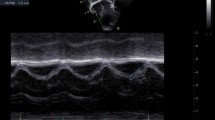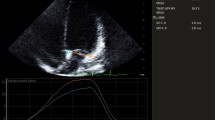Abstract.
The assessment of ventricular function plays an important role in the pre- and postoperative management of many congenital heart abnormalities. Normal ranges in left ventricular systolic function indices have been defined during childhood and age-related alterations in left ventricular myocardial contractile state have recently been reported. This study was carried out to investigate the developmental changes in left ventricular contractile state expressed by the endsystolic meridional stress (ESS)/rate-corrected velocity of circumferential fiber shortening (VCFc) relation, calculated by echo in normal children and young adults. We examined 146 healthy subjects (80 males and 66 females), mean age 70.85 ± 63.89 months (range 0.5–228) and body surface area (BSA) 0.807 ± 0.47 (range 0.18–2.01) with no clinical and echocardiographic evidence of cardiac disease and with normal blood pressure. The subjects were divided into three groups according to age: <6 months (group 1, n= 32), 6–36 months (group 2, n= 34), and >36 months (group 3, n= 80). Enddiastolic volume and mass (M) of the left ventricle were measured by M-mode Echo. ESS was considered as an index of afterload and the VCFc as an index of systolic ventricular function. The left ventricular ejection time used for the calculation of VCFc was measured from aortic flow obtained by PW–Doppler. The ESS/VCFc relation was used to assess left ventricular contractility. Systolic blood pressure, volume, and mass of the left ventricle increase with age. The gradual increase in pressure despite a stable mass/volume ratio [M/V = 0.900 + (0.0007 × age); r= 0.27, p < 0.005] resulted in a substantial increase of afterload [ESS = 29.78 + (0.116 × age); r= 0.58, p < 0.0001]. VCFc showed an inverse hyperbolic regression with afterload [VCFc = 1.01 + (7.598/ESS); r= 0.59, p < 0.0001]. The regression lines (best linear fit) between VCFc and ESS are significantly different in the three groups. The Y intercept was higher and the slope steeper in group 1 [VCFc = 1.74 − (0.017 × ESS); r= 0.65, p < 0.0005] vs group 2 [VCFc = 1.54 − (0.008 × ESS); r= 0.58, p < 0.001] and group 3 [VCFc = 1.52 − (0.007 × ESS); r= 0.57, p < 0.0001]. These data indicate that, in children, the volume and mass of the left ventricle increase, whereas the M/V ratio remains relatively constant; the progressive increase in arterial blood pressure explains the increase of afterload. The VCFc is higher in the first few years of life compared to that seen in older children due to reduced afterload and increased contractile state. Left ventricular contractility, expressed as ESS/VCFc relation, is thus inversely proportional to age. In the first months of life the left ventricular myocardium exhibits a higher basal contractile state and a greater sensitivity to changes in afterload. For obtaining an accurate assessment of left ventricular function, the ESS/VCFc relation in different age groups should be measured.
Similar content being viewed by others
Author information
Authors and Affiliations
Rights and permissions
About this article
Cite this article
Crepaz, R., Pitscheider, W., Radetti, G. et al. Age-Related Variation in Left Ventricular Myocardial Contractile State Expressed by the Stress Velocity Relation. Pediatr Cardiol 19, 463–467 (1998). https://doi.org/10.1007/s002469900358
Published:
Issue Date:
DOI: https://doi.org/10.1007/s002469900358




